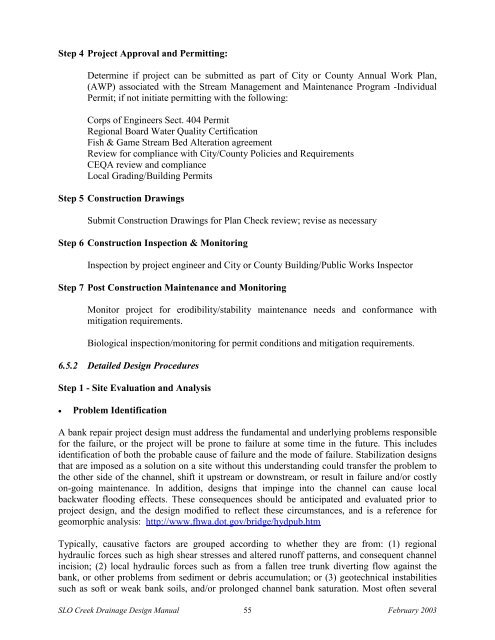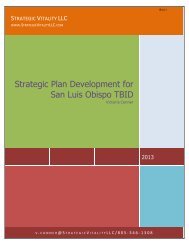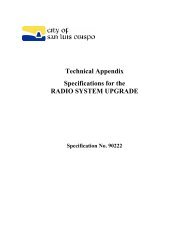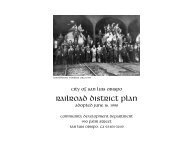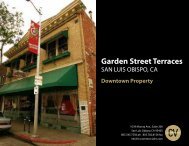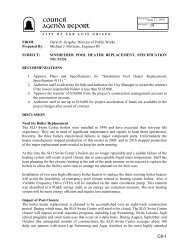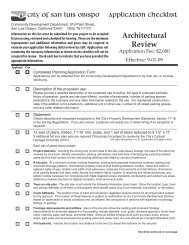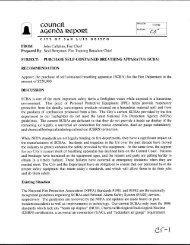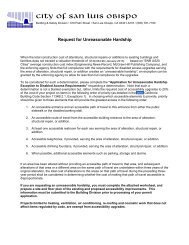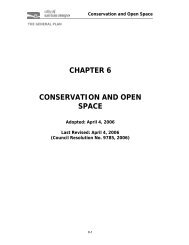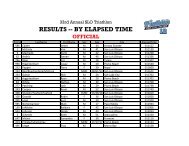Drainage Design Manual - the City of San Luis Obispo
Drainage Design Manual - the City of San Luis Obispo
Drainage Design Manual - the City of San Luis Obispo
You also want an ePaper? Increase the reach of your titles
YUMPU automatically turns print PDFs into web optimized ePapers that Google loves.
Step 4 Project Approval and Permitting:Determine if project can be submitted as part <strong>of</strong> <strong>City</strong> or County Annual Work Plan,(AWP) associated with <strong>the</strong> Stream Management and Maintenance Program -IndividualPermit; if not initiate permitting with <strong>the</strong> following:Corps <strong>of</strong> Engineers Sect. 404 PermitRegional Board Water Quality CertificationFish & Game Stream Bed Alteration agreementReview for compliance with <strong>City</strong>/County Policies and RequirementsCEQA review and complianceLocal Grading/Building PermitsStep 5 Construction DrawingsSubmit Construction Drawings for Plan Check review; revise as necessaryStep 6 Construction Inspection & MonitoringInspection by project engineer and <strong>City</strong> or County Building/Public Works InspectorStep 7 Post Construction Maintenance and MonitoringMonitor project for erodibility/stability maintenance needs and conformance withmitigation requirements.Biological inspection/monitoring for permit conditions and mitigation requirements.6.5.2 Detailed <strong>Design</strong> ProceduresStep 1 - Site Evaluation and AnalysisProblem IdentificationA bank repair project design must address <strong>the</strong> fundamental and underlying problems responsiblefor <strong>the</strong> failure, or <strong>the</strong> project will be prone to failure at some time in <strong>the</strong> future. This includesidentification <strong>of</strong> both <strong>the</strong> probable cause <strong>of</strong> failure and <strong>the</strong> mode <strong>of</strong> failure. Stabilization designsthat are imposed as a solution on a site without this understanding could transfer <strong>the</strong> problem to<strong>the</strong> o<strong>the</strong>r side <strong>of</strong> <strong>the</strong> channel, shift it upstream or downstream, or result in failure and/or costlyon-going maintenance. In addition, designs that impinge into <strong>the</strong> channel can cause localbackwater flooding effects. These consequences should be anticipated and evaluated prior toproject design, and <strong>the</strong> design modified to reflect <strong>the</strong>se circumstances, and is a reference forgeomorphic analysis: http://www.fhwa.dot.gov/bridge/hydpub.htmTypically, causative factors are grouped according to whe<strong>the</strong>r <strong>the</strong>y are from: (1) regionalhydraulic forces such as high shear stresses and altered run<strong>of</strong>f patterns, and consequent channelincision; (2) local hydraulic forces such as from a fallen tree trunk diverting flow against <strong>the</strong>bank, or o<strong>the</strong>r problems from sediment or debris accumulation; or (3) geotechnical instabilitiessuch as s<strong>of</strong>t or weak bank soils, and/or prolonged channel bank saturation. Most <strong>of</strong>ten severalSLO Creek <strong>Drainage</strong> <strong>Design</strong> <strong>Manual</strong> 55 February 2003


